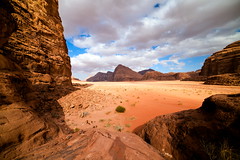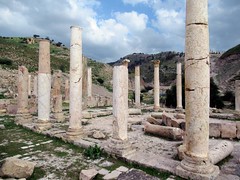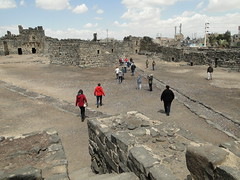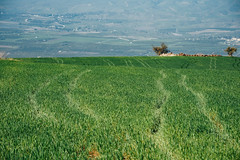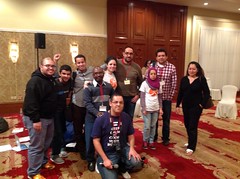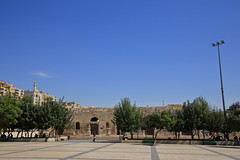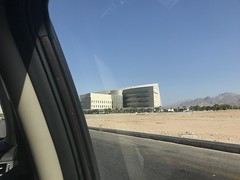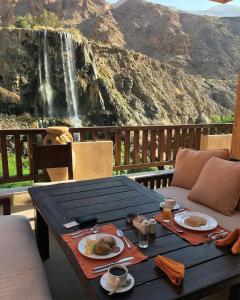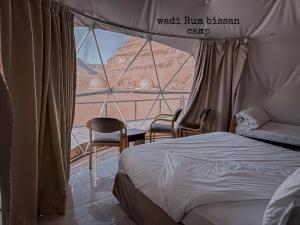 Jordan
Jordan
Jordan (Arabic: الأردن, tr. Arabic: [al.ʔur.dunː]), officially the Hashemite Kingdom of Jordan, is a country in Western Asia. It is situated at the crossroads of Asia, Africa, and Europe, within the Levant region, on the East Bank of the Jordan River. Jordan is bordered by Saudi Arabia to the south and east, Iraq to the northeast, Syria to the north, and the Palestinian West Bank, Israel, and the Dead Sea to the west. It has a coastline in its southwest on the Gulf of Aqaba's Red Sea, which separates Jordan from Egypt. Amman is Jordan's capital and largest city, as well as its economic, political, and cultural centre.
Modern-day Jordan has been inhabited by humans since the Paleolithic period. Three stable kingdoms emerged there at the end of the Bronze Age: Ammon, Moab and Edom. In the third century BC, the Arab Nabataeans established their Kingdom with Petra as the capital. Later rulers of the Transjordan region include the Assyrian, Babylonian, Roman, Byzantine, Rashidun, Umayyad, Abassid, and the Ottoman empires. After the Great Arab Revolt against the Ottomans in 1916 during World War I, the Greater Syria region was partitioned by Britain and France. The Emirate of Transjordan was established in 1921 by the Hashemite, then Emir, Abdullah I, and the emirate became a British protectorate. In 1946, Jordan gained independence and became officially known in Arabic as the Hashemite Kingdom of Jordan. The country captured the West Bank during the 1948 Arab–Israeli War and annexed it until it was lost to Israel in 1967. Jordan renounced its claim to the territory in 1988, and became the second Arab state to sign a peace treaty with Israel in 1994.
Jordan is a semi-arid country, covering an area of , with a population of 10 million, making it the eleventh-most populous Arab country. The dominant majority, or around 95% of the country's population, is Sunni Muslim, with a mostly Arab Christian minority. Jordan has been mostly unscathed by the violence that swept the region following the Arab Spring in 2010. From as early as 1948, Jordan has accepted refugees from multiple neighbouring countries in conflict. An estimated 2.1 million Palestinian and 1.4 million Syrian refugees are present in Jordan as of a 2015 census; with most Palestinian refugees holding Jordanian citizenship. The kingdom is also a refuge to thousands of Christian Iraqis fleeing persecution by the Islamic State. While Jordan continues to accept refugees, the recent large influx from Syria placed substantial strain on national resources and infrastructure.
The sovereign state is a constitutional monarchy, but the king holds wide executive and legislative powers. Jordan is a founding member of the Arab League and the Organisation of Islamic Co-operation. The country has a high Human Development Index, ranking 102nd, and is considered an upper middle income economy. The Jordanian economy, one of the smallest economies in the region, is attractive to foreign investors based upon a skilled workforce. The country is a major tourist destination, also attracting medical tourism due to its well developed health sector. Nonetheless, a lack of natural resources, large flow of refugees, and regional turmoil have hampered economic growth.
Etymology
Jordan takes its name from the Jordan River, which forms much of the country's northwestern border. While several theories for the origin of the river's name have been proposed, it is most plausible that it derives from the Hebrew word Yarad (Hebrew: ירד), meaning "the descender", reflecting the river's declivity. Much of the area that makes up modern Jordan was historically called Transjordan, meaning "across the Jordan", used to denote the lands east of the river. The Hebrew Bible (the founding holy text of Judaism, also referred to by Christians as the Old Testament) refers to the area as Hebrew: עבר הירדן. Early Arab chronicles referred to the river as Al-Urdunn, corresponding to the Hebrew Yarden. Jund Al-Urdunn was a military district around the river in the early Islamic era. Later, during the Crusades in the beginning of the second millennium, a lordship was established in the area under the name of Oultrejordain.
History
Ancient period
The oldest known evidence of hominid habitation in Jordan dates back at least 200,000 years. Jordan is rich in Paleolithic remains (up to 20,000 years old) due to its location within the Levant where expansions of hominids out of Africa converged, as well as due to its more humid climate during the Late Pleistocene, resulting in the formation of numerous wetlands in the region. Past lakeshore environments attracted different hominids, and several remains of tools have been found from this period. Scientists have found the world's oldest known evidence of bread-making in a 14,500 year-old Natufian site in Jordan's northeastern desert. A transition from hunter-gatherer culture to establishing populous agricultural villages occurred during the Neolithic period (10,000–4,500 BC). 'Ain Ghazal, one such village located at a site in the east of present-day Amman, is one of the largest known prehistoric settlements in the Near East. Dozens of plaster statues of the human form dating to 7250 BC or earlier have been uncovered there; they are "among the earliest large-scale representations of the human form" ever found. Other than the Chalcolithic (4500–3600 BC) villages such as Tulaylet Ghassul in the Jordan Valley, a series of circular stone enclosures in the eastern basalt desert continue to baffle archaeologists about their purpose.
Fortified towns and urban centres first emerged in the southern Levant early on in the Bronze Age (3600–1200 BC). Wadi Feynan became a regional centre for copper extraction - the metal was exploited on a large-scale to produce bronze. Trade and movement of people in the Middle East peaked, spreading and refining civilizations. Villages in Transjordan expanded rapidly in areas with reliable water-resources and agricultural land. Ancient Egyptians expanded towards the Levant and came to control both banks of the Jordan River.
During the Iron Age (1200–332 BC) after the withdrawal of the Egyptians, Transjordan was home to the Kingdoms of Ammon, Edom and Moab. The peoples of these kingdoms spoke Semitic languages of the Canaanite group; their polities are considered by archaeologists to have been tribal kingdoms rather than states. Ammon was located in the Amman plateau; Moab in the highlands east of the Dead Sea; and Edom in the area around Wadi Araba in the south. The northwestern region of the Transjordan, known then as Gilead, was settled by the Israelites. The Transjordanian kingdoms of Ammon, Edom and Moab continually clashed with the neighbouring Hebrew kingdoms of Israel and Judah, centered west of the Jordan River. One record of this is the Mesha Stele, erected by the Moabite king Mesha in 840 BC; on it he lauds himself for the building projects that he initiated in Moab and commemorates his glory and victory against the Israelites. The stele constitutes one of the most important archeological parallels of accounts recorded in the Bible. At the same time, Israel and the Kingdom of Aram-Damascus competed for control of the Gilead.
Around 740 to 720 BC Israel and Aram Damascus were conquered by the Neo-Assyrian Empire. The kingdoms of Ammon, Edom & Moab were subjugated, but were allowed to maintain some degree of independence.
Babylonians took over the Assyrians' empire after its disintegration in 627 BC. Although the kingdoms supported the Babylonians against Judah in the 597 BC sack of Jerusalem, they rebelled against Babylon a decade later. The kingdoms were reduced to vassals, a status they retained under the Persian and Hellenic Empires. By the beginning of Roman rule around 63 BC, the kingdoms of Ammon, Edom and Moab had lost their distinct identities, and were assimilated into the Roman culture. Some Edomites survived longer – driven by the Nabataeans, they had migrated to southern Judea, which became known as Idumaea; They were later converted to Judaism by the Hasmoneans.
Classical period
Alexander the Great's conquest of the Persian Empire in 332 BC introduced Hellenistic culture to the Middle East. After Alexander's death in 323 BC, the empire split among his generals, and in the end much of Transjordan was disputed between the Ptolemies based in Egypt and the Seleucids based in Syria. The Nabataeans, nomadic Arabs based south of Edom, managed to establish an independent kingdom in 169 BC by exploiting the struggle between the two Greek powers. The Nabataean Kingdom controlled much of the trade routes of the region, and it stretched south along the Red Sea coast into the Hejaz desert, up to as far north as Damascus, which it controlled for a short period (85–71) BC. The Nabataeans massed a fortune from their control of the trade routes, often drawing the envy of their neighbours. Petra, Nabataea's barren capital, flourished in the 1st century AD, driven by its extensive water irrigation systems and agriculture. The Nabataeans were also talented stone carvers, building their most elaborate structure, Al-Khazneh, in the first century AD. It is believed to be the mausoleum of the Arab Nabataean King Aretas IV.
Roman legions under Pompey conquered much of the Levant in 63 BC, inaugurating a period of Roman rule that lasted four centuries. In 106 AD, Emperor Trajan annexed Nabataea unopposed, and rebuilt the King's Highway which became known as the Via Traiana Nova road. The Romans gave the Greek cities of Transjordan–Philadelphia (Amman), Gerasa (Jerash), Gedara (Umm Quays), Pella (Tabaqat Fahl) and Arbila (Irbid)–and other Hellenistic cities in Palestine and southern Syria, a level of autonomy by forming the Decapolis, a ten-city league. Jerash is one of the best preserved Roman cities in the East; it was even visited by Emperor Hadrian during his journey to Palestine.
In 324 AD, the Roman Empire split and the Eastern Roman Empire–later know…

